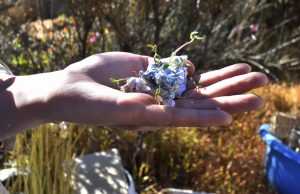 By Gina Baldivieso
By Gina Baldivieso
La Paz, Jul 29 (efe-epa).- Used paper has a new life in the laboratory of Bolivia’s Cecilia Tapia, who combines it with seeds and vegetable fibers like banana, pineapple and cattail leaves to create artistic handcrafted sheets of paper capable of growing flowers if planted.
An ecological engineer by profession, Tapia told EFE that she always had an urge to help protect the environment, above all by recycling.
“I wanted to show people they can use paper twice…that they can recycle it and so protect our biodiversity,” she said.
That led her to create Bohemia Paper, a project focused “on conservation,” with the conviction that “everyone can contribute a grain of sand” to that mission.
After graduating from university she won a contest for entrepreneurs that awarded her “seed capital” of $1,000, with which she was able to launch Bohemia Paper in 2012.
When she started the project, the businesswoman had to combine it with her work in a non-governmental organization, a job she dropped three years ago to dedicate herself 100 percent to her eco-project.
Tapia now works in her La Paz workshop amid shelves laden with different kinds of paper, vegetal waste and other materials, plus some huge water tanks for soaking the paper.
The production process begins with the collection of waste paper, white sheets, notebooks and cardboard, with offices and schools as her main suppliers.
“What we can’t use is fax paper, carbon paper, plasticized paper or magazines that use coated paper, or even newspapers,” she said.
The entrepreneur showed how the paper is put through a process of being cut up, soaked and submitted to a kind of liquefaction to make pulp, the basis for making the new handcrafted leaves of paper.
What’s new about this biodegradable paper is that the pulp is mixed with seeds, vegetable fibers, rinds, bioresiduals, leaves of banana trees and cattails, and dried flowers “to give the paper textures and colors,” Tapia said.
The paper that contains seeds “can return to the earth,” because when put in a pot “it can grow flowers” or herbs like chamomile, Peruvian black mint or Bolivian coriander, “which are the ones we use,” she said.
Her own business cards are samples. On the back they say “Sow me. Take care of me. Watch a new life grow.” Yes, her own card can grow flowers if planted and watered.
In order to make these cards only seeds that measure 1 millimeter (4/100 of an inch) are used “that can be contained within the paper,” while bits of colored pencils are used for the more artistic.
Bohemia Paper products are “laboriously” made by hand, which gives them a “unique” finish.
“Each sheet is different from the others, which is appreciated by artists and foreigners looking for products with a sustainable production process that is environment-friendly, since we don’t use bleach or toxic aniline dyes,” Tapia said.
Bohemia Paper makes business cards, calendars, bookmarks, certificates, wedding invitations, birthday cards, books and more.
Tapia daily produces between 30 and 40 sheets of paper, though special orders, like papers with dried flowers or coca leaves, take a little more time because they require “being worked in greater detail.”
Another trait of Bohemia Paper is its ability to produce items creatively “personalized” to the client’s taste. For example, the menu of a cafe can be made of paper made with leftover coffee grounds.
Tapia’s workshop is in La Paz, but the businesswoman notes that “more people could take up this work,” and to make sure they do, she offers training courses, above all in rural communities, so other women “can start a business.”
Bohemia Paper has received orders from the United States and Germany, though their main clients are local “socio-environmental” enterprises that want items like labels for clothing or to identify the contents of containers.
The message Tapia seeks to give with her project is that it is possible “to create an economy with materials that are being wasted and which, instead of dumping them in a landfill, can be given a second chance.”
She also wishes to show that it is possible to produce “in an environmentally friendly way, without polluting the water or the land.”
